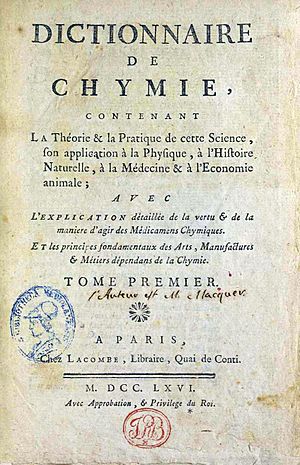Pierre Macquer facts for kids
Quick facts for kids
Pierre-Joseph Macquer
|
|
|---|---|
 |
|
| Born | 9 October 1718 |
| Died | 15 February 1784 (aged 65) |
| Nationality | French |
| Known for | Dictionary of Chemistry |
| Scientific career | |
| Fields | Chemistry |
| Influences | Georges-Louis Leclerc, Comte de Buffon Guillaume-François Rouelle |
| Influenced | Antoine-Laurent de Lavoisier Geneviève Thiroux d'Arconville |
Pierre-Joseph Macquer (born October 9, 1718 – died February 15, 1784) was an important French chemist. He made many contributions to the world of science.
He is best known for his book, Dictionnaire de chymie (Dictionary of Chemistry), published in 1766. Macquer also used his chemistry skills in practical ways. He helped develop porcelain in France. He worked as a chemist for big industries. These included the Manufacture de Sèvres and the Gobelins Manufactory. His brother, Phillipe Macquer, was also a scholar.
Contents
Discoveries and Ideas
Understanding Prussian Blue
In 1752, Macquer made an important discovery about a blue color called Prussian blue. This color was used as a pigment. He found that he could break down Prussian blue. He used special liquid solutions called alkaline solutions. This process separated it into two parts. One part was a solid iron compound. The other was a liquid solution called Ferrocyanide.
Chemical Affinity Explained
In 1749, Macquer wrote a book called Elemens de Chymie Theorique. In this book, he talked a lot about chemical affinity. This is the idea that different substances are attracted to each other. They want to combine and form new things.
He explained that experiments show how bodies "agree" or "attract" each other. This means some substances easily join together. Others cannot combine at all. Macquer believed this idea helped explain all chemical reactions. He thought it could connect all the facts found in chemistry.
All the experiments that have been hitherto carried out, and those that are still being daily performed, concur in proving that between different bodies, whether principles or compounds, there is an agreement, relation, affinity or attraction (if you will have it so), which disposes certain bodies to unite with one another, while with others they are unable to contract any union: it is this effect, whatever be its cause, which will help us to give a reason for all the phenomena furnished by chemistry, and to tie them together.
Career and Recognition
Macquer was a respected scientist. He joined the French Academy of Sciences on April 5, 1745. He started as an adjunct chemist. Later, he became an associate chemist in 1766. In 1772, he was given the permanent Chair of Chemistry. This was a very important position.
His work was recognized internationally. In 1768, he was chosen as a foreign member. This was for the Royal Swedish Academy of Sciences. In 1775, he became a member of the American Philosophical Society. This showed how important his contributions were to science.
A chemical compound is named after him. It is called Macquer's salt. Its scientific name is monopotassium arsenate (KH2AsO4).
Works
- 1756: Elemens de Chymietheoretique
- 1766: Dictionnaire portatif des arts et metiers, volume 1
- 1766: Dictionnaire portatif des arts et metiers, volume 2
See also
 In Spanish: Pierre Joseph Macquer para niños
In Spanish: Pierre Joseph Macquer para niños


